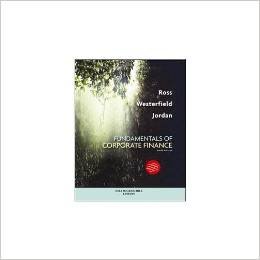
Case summary:
Person C and Person GR are the founders and owners of R Company. This company manufactures and installs heating, ventilation, and cooling units (HVAC) commercially. Both the owners have 50,000 shares of the company’s stock, as per the
R Company has earnings per share of $3.75 and dividends of $48,000 each were paid to the owners of the company. Moreover, there is even a
Characters in the case:
R Company: The firm that wants to value their stocks.
Person C: Co-owner of Company R.
Person GR: Co-owner of Company R.
To determine: The estimate of stock price on the assumption of growth rate.
Answer to Problem 2M
The estimate of stock price is $41.66.
Explanation of Solution
Given information:
The earnings per share are $3.75, Return on Equity (ROE) is 17%, and the required rate of return is 14%. The earnings per share without the write-off are $1.10. The earnings per share of AC Company is $1.30 and NH Company (both are competitors) is $1.95.
The industry average of earnings per share is $0.96, dividend per share is $0.16, and the rate of return is 11.67%. The industry average ROE is 10% and the dividend paid per share in the current year is $0.96 (refer to the previous problem-computed value).
Formula:
The formula to calculate the industry (competitor’s) earnings per share:
The formula to calculate the industry payout ratio:
The formula to calculate the industry retention ratio:
The formula to calculate the industry growth rate:
The formula to calculate the total dividends for the next year:
Where,
D1 refers to the expected dividend per share in the next period.
The formula to calculate the stock price in Year 5:
The formula to calculate the current total value of the stock price:
Where,
Po refers to the price of the stock,
D1 refers to the expected dividend per share in the next period,
R refers to the required rate of return on its stock,
grefers to the constant rate of growth.
Compute the industry earnings per share:
Hence, the industry earnings per share are $1.45.
Compute the industry payout ratio:
Hence, theindustrypayout ratio is 0.1103 or 11.03%.
Compute the industry retention ratio:
Hence, the industry retention ratio is 0.8897 or 88.97%.
Compute the industry growth rate:
Hence, the industry growth rate of the company is 0.08897 or 8.897%.
Note: The Company has continued to grow at a fast pace in the current five years before the slowdown of the industry growth rate. Compute the total dividends for each of the next 6 years, as a result of the aforementioned growth rate.
Compute the dividend for Year 1:
Hence, the dividend for Year 1 is $1.065.
Compute the dividend for Year 2:
Hence, the dividend for Year 2 is $1.18.
Compute the dividend for Year 3:
Hence, the dividend for Year 3 is $1.31.
Compute the dividend for Year 4:
Hence, the dividend for Year 4 is $1.45.
Compute the dividend for Year 5:
Hence, the dividend for Year 5 is $1.61.
Compute the dividend for Year 6:
Hence, the dividend for Year 6 is $1.78.
Compute the stock price in Year 5:
Hence, the stock price of Year 5 is $64.19.
Compute the stock price:
Hence, the stock price is $41.66.
Want to see more full solutions like this?
Chapter 8 Solutions
Fundamentals Of Corporate Finance, Tenth Standard Edition
- What is the purpose of diversification in an investment portfolio, and how does it reduce risk? Need help!arrow_forwardWhat are the key differences between a company’s income statement and its cash flow statement? Why are both important for financial analysis? Need help!arrow_forwardWhat are the key differences between a company’s income statement and its cash flow statement? Why are both important for financial analysis?arrow_forward
- What is the relationship between risk and return in finance, and how is this reflected in the Capital Asset Pricing Model (CAPM)? Explain.arrow_forwardDefine the time value of money (TVM). How does TVM influence decision-making in capital budgeting? Explanation.arrow_forwardWhat is the relationship between risk and return in finance, and how is this reflected in the Capital Asset Pricing Model (CAPM)?arrow_forward
- 3. Explain the concept of compounding. How does compounding impact the future value of an investment? Need help!arrow_forward3. Explain the concept of compounding. How does compounding impact the future value of an investment?arrow_forwardWhat is the difference between a stock and a bond, and how do they function as investment options? Need help now !arrow_forward
- What is the difference between a stock and a bond, and how do they function as investment options? Rxplarrow_forwardWhat does the internal rate of return (IRR) tell you about a potential investment? Rxarrow_forwardWhy is the Weighted Average Cost of Capital (WACC) important for a company's decision-making? Explanation.arrow_forward
 Essentials Of InvestmentsFinanceISBN:9781260013924Author:Bodie, Zvi, Kane, Alex, MARCUS, Alan J.Publisher:Mcgraw-hill Education,
Essentials Of InvestmentsFinanceISBN:9781260013924Author:Bodie, Zvi, Kane, Alex, MARCUS, Alan J.Publisher:Mcgraw-hill Education,

 Foundations Of FinanceFinanceISBN:9780134897264Author:KEOWN, Arthur J., Martin, John D., PETTY, J. WilliamPublisher:Pearson,
Foundations Of FinanceFinanceISBN:9780134897264Author:KEOWN, Arthur J., Martin, John D., PETTY, J. WilliamPublisher:Pearson, Fundamentals of Financial Management (MindTap Cou...FinanceISBN:9781337395250Author:Eugene F. Brigham, Joel F. HoustonPublisher:Cengage Learning
Fundamentals of Financial Management (MindTap Cou...FinanceISBN:9781337395250Author:Eugene F. Brigham, Joel F. HoustonPublisher:Cengage Learning Corporate Finance (The Mcgraw-hill/Irwin Series i...FinanceISBN:9780077861759Author:Stephen A. Ross Franco Modigliani Professor of Financial Economics Professor, Randolph W Westerfield Robert R. Dockson Deans Chair in Bus. Admin., Jeffrey Jaffe, Bradford D Jordan ProfessorPublisher:McGraw-Hill Education
Corporate Finance (The Mcgraw-hill/Irwin Series i...FinanceISBN:9780077861759Author:Stephen A. Ross Franco Modigliani Professor of Financial Economics Professor, Randolph W Westerfield Robert R. Dockson Deans Chair in Bus. Admin., Jeffrey Jaffe, Bradford D Jordan ProfessorPublisher:McGraw-Hill Education





